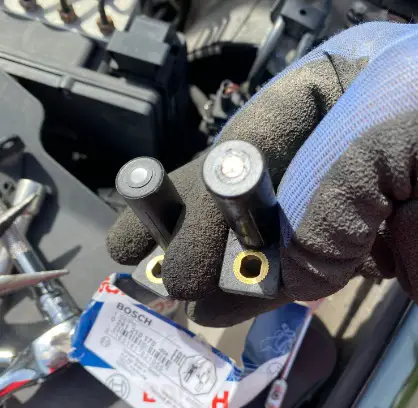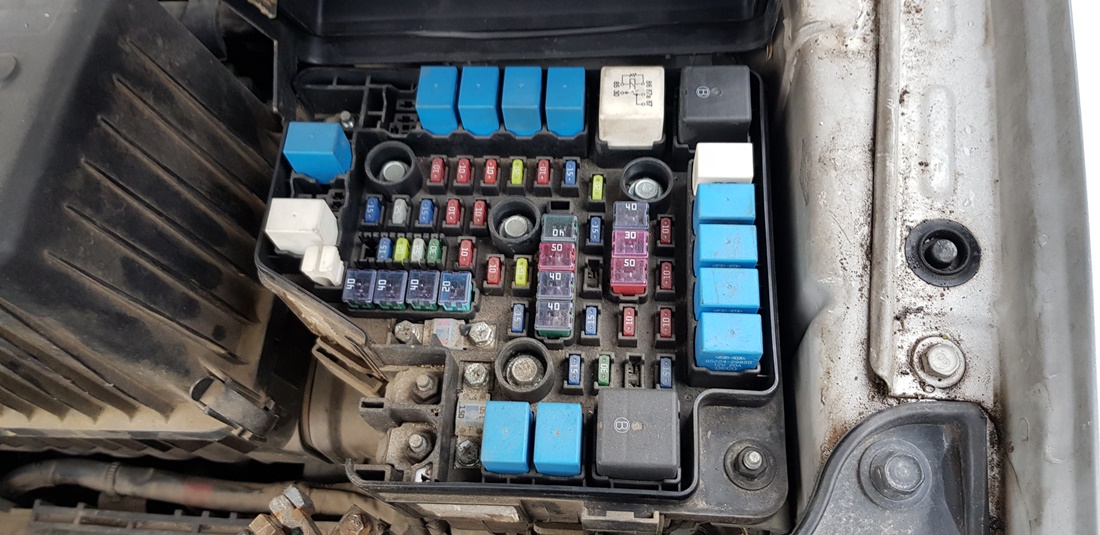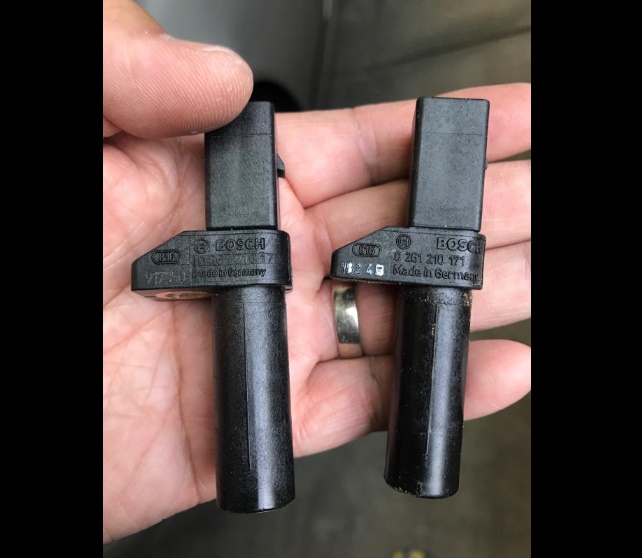As we all know, when a car overheats, the damage could be significant and expensive. Some cars just won’t start after overheating. One might think that this is it.
However, there is more to it. When a car overheats, it can melt a couple of important wiring and the car won’t start.
In this blog post, I will be talking about why a car won’t start after overheating.
After reading this article, you will have a basic understanding of what happens when an engine overheats, and how to get your car up and running again.
- Key Takeaway
- Why A Car Won’t Start After Overheating
- How To Fix an Overheated Engine
- How To Prevent Engine Overheating
- FAQs
- Q: What is a blown head gasket?
- Q: How can I check if my head gasket is blown?
- Q: Can a damaged radiator cause the car not to start?
- Q: What can cause a faulty thermostat?
- Q: How do I know if my thermostat is faulty?
- Q: Can an overheating engine cause a seized engine?
- Q: What should I do if my car overheats?
- Q: How much does it cost to repair a blown head gasket?
- Conclusion and final thoughts
Key Takeaway
- A car may not start after overheating if the head gasket is blown, the cylinder heads are melted or warped from the high temperature, the electronic sensors melted from the heat, warped or melted belts, burst hoses, and warped cylinder block which leads to loss of compression.
- Fixing an overheated engine involves reducing the engine heat immediately, safely stopping the vehicle, allowing it to cool, checking and refilling coolant if necessary, inspecting the cooling system for issues, and seeking professional help if the problem persists or is not identifiable.
- Preventing engine overheating involves regular maintenance of the cooling system, consistent monitoring and topping up of coolant levels, mindful driving habits to avoid straining the engine, keeping the interior of your car cooler by using covers, inspecting engine belts and radiator cap, and ensuring your condenser is clean.
Why A Car Won’t Start After Overheating

If your car won’t start after overheating, it could be due to a number of reasons. In the list below, you will find the most common causes why a car won’t start after overheating:
1. Blown head gasket

A head gasket is a crucial component of any car engine, and it plays an important role in keeping the engine running smoothly. The head gasket seals the space between the engine block and the cylinder head, and it prevents oil and coolant from leaking out.
The head gasket seals the engine block and cylinder head, keeping coolant and oil from leaking out. When the engine overheats, the head gasket can warp or break, causing a loss of pressure. As a result, the engine may not be able to start.
A blown head gasket is a very serious issue for any car owner. There are a few signs that you can look for that may indicate a blown head gasket. An engine with a blown head gasket will rarely be able to start. However, if you are somehow able to start the engine, it will overheat very fast.
If your engine temperature starts to rise higher than normal, or if it starts to overheat more quickly than usual, it could be a sign that your head gasket is blown. You may also notice white smoke coming from your exhaust pipe, or coolant leaking from under your hood.
The head gasket is what keeps the oil and coolant flowing separately in the engine. When the head gasket is blown, those two would mix and will either leak out of the engine or get burned in the combustion chamber and get out of the exhaust pipe.
2. Warped or melted cylinder heads

The cylinder head of an engine is responsible for a number of vital functions. chief among these is the sealing of the cylinders, which prevents the escape of compression and the entry of oil or coolant.
The cylinder head also houses the valves, which regulate the flow of air and fuel into the cylinders, as well as the spark plugs, which ignite the fuel-air mixture.
In addition, the cylinder head plays a role in cooling the engine, as it contains a number of passageways through which coolant can flow. Finally, the cylinder head provides a mount for the camshafts, which actuate the valves. As such, it is clear that the cylinder head is a crucial component of any engine.
Warped cylinder heads are one possible reason why a car might not start after overheating. If the engine gets too hot, the metal can expand and distort the shape of the cylinder heads.
This can cause problems with the way the pistons move up and down, preventing the engine from starting. In some cases, warped cylinder heads can be repaired by a mechanic. However, in severe cases, they may need to be replaced.
One way to check for a warped cylinder head is to use a feeler gauge. First, clean the area around the spark plug hole and remove the spark plug. Next, insert the feeler gauge into the spark plug hole and measure the gap between the gauge and the cylinder head. If the gap is more than 0.004 inches, then the cylinder head is most likely warped.
Another way to check for a warped cylinder head is to use a straight edge. Place the straight edge across the top of the cylinder head and see if there are any gaps between the straight edge and the cylinder head. If there are gaps, then the cylinder head is probably warped.
3. Warped or melted electronic sensors

If your car overheats and then won’t start, there’s a good chance that one of the electronic sensors has melted. The sensors are located in the engine and control a variety of functions, including ignition timing and fuel injection. When they get too hot, they can melt and cause all sorts of problems.
The electronic ignition system in your car uses sensors to control the ignition timing. These sensors are located at the front and rear of the engine, and they send signals to the electronic control unit (ECU). The ECU then adjusts the timing of the spark plugs so that they fire at the correct time. This ensures that the engine runs smoothly and efficiently.
Another electronic sensor that is super important is the fuel injection sensor. In order for the engine to run properly, it needs the right mixture of air and fuel. Too much of either one can cause serious problems. However, electronic sensors can help to ensure that the engine always has the perfect mixture of air and fuel.
These sensors are located in the air intake and the exhaust system, and they constantly monitor the amount of air and fuel being used by the engine. If the sensor detects that the mixture is too rich or too lean, it will adjust the amount of fuel being injected into the engine.
4. Warped or melted belts

There are several types of belts in a car, each with a different purpose. The fan belt helps to cool the engine by driving the water pump and fan. The alternator belt powers the alternator, which in turn charges the battery.
The power steering belt provides power assistance to the steering system. Finally, the serpentine belt drives all of the pulleys on the engine, including the water pump, fan, alternator, and power steering pump. Each of these belts is critical to the proper functioning of a car.
The belts in a car are made of a variety of materials, depending on the type of belt and its intended use. V-belts, for example, are often made of synthetic rubber, while timing belts are typically made of reinforced fiberglass or Kevlar. Serpentine belts, which are used to drive accessories such as the alternator and power steering pump, are usually made of EPDM rubber.
Overheating can cause major damage to your car. If the temperature gauge needle moves into the red, it’s time to pull over. Continued driving could cause the engine to seize. Melted belts are one reason a car won’t start after overheating says Berryman Products.
The serpentine belt, timing belt, or fan belt can slip off its pulley if it gets too hot. The coolant pump may also stop working if the belts melted. Inspect the front of the engine for any signs of melted plastic.
5. Brust hoses

Overheating is a common problem with cars, and it can have a variety of causes. In some cases, the radiator may be low on fluid or there may be a problem with the water pump. However, one of the most common reasons for an overheated engine is a burst hose.
A hose carries coolant through the radiator and back to the engine, and if it springs a leak, the coolant can quickly drain out. As a result, the engine will overheat and may eventually seize up. If you find yourself stranded with an overheated engine, check the hoses for signs of leaks or damage.
You will first need to fix the hose and add coolant to the radiator. Then, you can try and start your vehicle. However, if you try to start your vehicle without fixing the issue, there is a great chance that the car won’t start after overheating.
6. Warped engine block – loss of compression

The engine block of a car is the central component of the vehicle’s engine. It is typically made from cast iron or aluminum and houses the various parts of the engine, such as the cylinders, pistons, and crankshaft.
The engine block is also responsible for distributing heat evenly throughout the engine and keeping it cool. In addition, it helps to reduce noise by absorbing vibrations. Engine blocks are typically very durable and can last the lifetime of a car with proper care and maintenance.
One possible reason your car won’t start after overheating is a warped engine block. When a car overheats, the engine block can be damaged in a number of ways. Firstly, excessive heat can cause the engine oil to break down, resulting in increased friction and wear on the engine components.
Additionally, the heat can cause the metal to expand, resulting in warped cylinder heads and cracked piston rings. Finally, the overheating can cause the coolant to boil, resulting in steam pockets that can damage the engine block. In severe cases, the engine block may crack or melt completely, rendering the car inoperable.
How To Fix an Overheated Engine
Fixing an overheated engine involves an immediate response to reduce heat, followed by a thorough check of the cooling system and necessary repairs.
Reduce Engine Heat
The first step in dealing with an overheated engine is to try and reduce the engine heat. Immediately turn off your air conditioner and turn on the car’s heater to its highest and hottest setting. I’ve found in my years as a mechanic that this can help draw some of the heat away from the engine.
Safely Stop the Vehicle
If the temperature gauge continues to rise, the next step is to safely pull over and stop the vehicle. Turn off the engine to allow it to cool. It’s important to wait for at least 15-30 minutes before attempting to open the hood due to the risk of steam or hot coolant causing burns.
Check and Add Coolant
Once the engine has cooled down, open the hood and check the coolant level in the overflow tank. If it’s empty or low, you’ll need to add more coolant. In my experience, an engine often overheats due to insufficient coolant, so this step is crucial.
Inspect Cooling System
Next, inspect the cooling system for any visible issues such as leaks, damaged hoses, or a broken fan belt. These are common causes of overheating that I’ve encountered numerous times in my mechanic career.
Seek Professional Assistance
If the problem persists or if you’re unable to identify the issue, it’s time to take the vehicle to a professional. As a mechanic, I can tell you that an overheating engine can be a symptom of several potential problems, so it’s important to get a comprehensive check to prevent further damage.
How To Prevent Engine Overheating
Preventing engine overheating involves regular maintenance of the cooling system, monitoring fluid levels, and mindful driving habits.
Regular Maintenance
Regular maintenance is key to preventing engine overheating. This includes making sure that your vehicle’s cooling system – radiator, water pump, thermostat, and hoses – is in good working order. As a mechanic, I’ve found that many cases of engine overheating could have been prevented with routine checks and maintenance.
Monitor Fluid Levels
It’s important to consistently monitor and maintain proper levels of coolant in your vehicle. Coolant, or antifreeze, absorbs the heat from the engine and dissipates it through the radiator. In my years as a mechanic, I’ve seen how low coolant levels can lead to engine overheating. Therefore, regularly checking and topping up your coolant can go a long way in preventing this issue.
Mindful Driving Habits
Adopting mindful driving habits can also help prevent engine overheating. Avoid hard accelerations, especially in hot weather or when you’re carrying heavy loads, as these can put additional strain on the engine. I’ve often advised customers in my workshop to be mindful of their driving habits, especially during summer months or on long trips.
Address Issues Promptly
Finally, if you notice any issues such as leaks, unusual noises, or performance issues, get them checked out promptly by a professional. Ignoring small problems can lead to bigger ones down the line. Having worked as a mechanic for many years, I’ve seen how delaying minor repairs can often lead to major issues like engine overheating.
FAQs
Q: What is a blown head gasket?
A: A blown head gasket is a common problem that can occur when a car engine overheats. It is a break or breach in the gasket that seals the cylinder head to the engine block. This can lead to coolant and engine oil mixing, resulting in engine failure and difficulty starting the car.
Q: How can I check if my head gasket is blown?
A: There are a few signs that indicate a blown head gasket, such as white or blue smoke coming from the exhaust, coolant mixing with the engine oil, loss of coolant without any visible leaks, and an overheating engine. However, it is best to have a professional mechanic perform a proper diagnosis.
Q: Can a damaged radiator cause the car not to start?
A: Yes, if a car’s radiator is damaged or leaking, it can cause overheating and subsequent engine failure. When the engine reaches a certain temperature, it may shut down to prevent further damage. In such cases, the car will not start until the radiator is repaired or replaced.
Q: What can cause a faulty thermostat?
A: A faulty thermostat can cause a car not to start after overheating. If the thermostat is stuck in the closed position, it may prevent coolant from circulating and cooling down the engine. This can result in overheating and subsequent starting issues.
Q: How do I know if my thermostat is faulty?
A: Signs of a faulty thermostat include an overheating engine, fluctuating temperature gauge, no heat coming from the vents when the heater is on, and coolant leaks. However, it is recommended to have a professional mechanic diagnose and replace the thermostat if necessary.
Q: Can an overheating engine cause a seized engine?
A: Yes, when an engine overheats, the metal components can expand and warp, causing the moving parts to seize or lock up. If the engine seizes, it will not be able to start, and extensive repairs or engine replacement may be needed.
Q: What should I do if my car overheats?
A: If your car starts to overheat, it is important to take immediate action. Pull over to a safe location, turn off the engine, and allow it to cool down. Do not attempt to open the radiator cap while the engine is hot. Once the engine has cooled, check the coolant levels and add more if necessary. If the problem persists, it is advisable to have the car inspected by a professional mechanic.
Q: How much does it cost to repair a blown head gasket?
A: The cost to repair a blown head gasket can vary depending on several factors, such as the make and model of the car, the extent of the damage, and the labor rates in your area. On average, the cost can range from $1,000 to $2,500. It is best to get multiple quotes from reputable mechanics to get an accurate estimate.
Conclusion and final thoughts
In conclusion, a car not starting after overheating is a common issue that many drivers may face at some point in their ownership.
It is important to remember that this problem could have multiple causes, such as a malfunctioning battery or starter motor, low coolant levels, or a blown head gasket.




